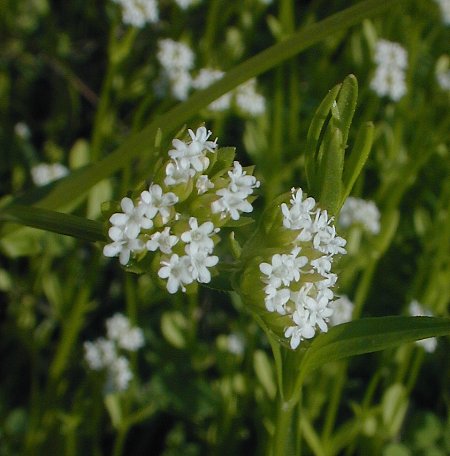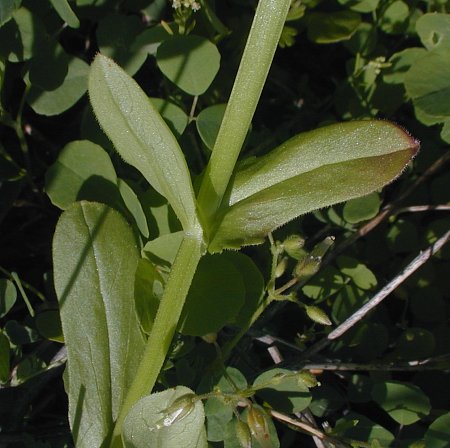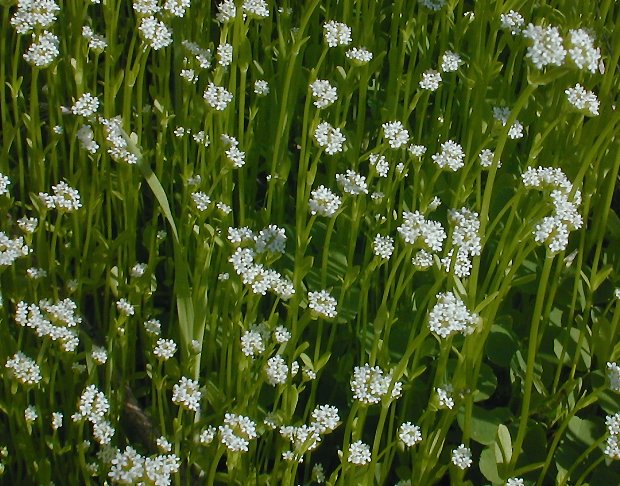Description: This plant is a winter annual that becomes 4-16" tall. It forms a low rosette during the fall and bolts during the spring. The central stem is four-sided and stout, sometimes with fine hairs along the ridges. This stem may branch dichotomously in the upper half of the plant. The opposite leaves are up to 3" long and 1" across, oblong or oblanceolate in shape, and they usually clasp the stem. Each leaf has a prominent central vein, and a margin that is smooth or with a few coarse teeth toward the base. Sometimes there are fine hairs along the leaf margins. The upper stems produce flat-topped clusters of small white flowers. A typical flower cluster will be about ½–1" across and contain 4-12 flowers, which are surrounded by triangular green bracts.

Each flower is
about 1/8" (3 mm.) across, and consists of a short corolla with 5 small
lobes
that are without notches at their tips. There are 3 white stamens, and
a central stigma with a tripartite style at its tip. The blooming
period occurs from mid- to late spring, and lasts about a month. There
is little or no floral scent. Each flower is replaced by a ridged
3-chambered fruit that is oval-shaped and longer than it is wide. Only
one chamber of the fruit is fertile, which contains a single seed. The
root system consists of a slender, branching taproot that is white.
Cultivation:
The preference is full sun and moist conditions. This plant will grow
in soil that is loamy or somewhat gravelly. Partial sun and more mesic
conditions are also tolerated, although growth will be less robust.
Disease and insects don't seem to bother this plant to any significant
degree. This plant has a strong tendency to form colonies by re-seeding
itself.

Range &
Habitat:
Beaked Corn Salad occurs primarily in southern Illinois, where it is
fairly common. It can also be found parts of central Illinois, where it
is uncommon (see Distribution
Map). Habitats include disturbed areas of moist meadows,
openings in floodplain forests, glades, abandoned fields, and
miscellaneous waste areas. This is by far the most common Valerianella
sp. in Illinois, the other species being restricted to a few
NE counties in the state.
Faunal Associations:
Miscellaneous insects visit the flowers primarily for nectar, including
small bees, Eumenine wasps, Syrphid flies, and other kinds of flies.
Among the bees, are such visitors as little carpenter bees (Ceratina
spp.), masked bees (Hylaeus spp.), mason
bees (Osmia spp.), and various Halictid bees. Like
other species of corn salad (Valerianella spp.), the
foliage is non-toxic and it may be eaten
by mammalian herbivores. It is unclear if the seeds can pass through
the gullets of such animals and still germinate.
Photographic Location:
The photographs were taken at a gravelly waste area near a railroad in
Champaign, Illinois, where the plants are probably adventive from the
south.

Comments: This little plant can be quite showy during the spring when it forms large colonies, otherwise it is easy to overlook. Distinguishing the different corn salad species (Valerianella spp.) can be difficult without examining the shape of their fruits, or the size and color of their flowers. Beaked Corn Salad differs from the cultivated Corn Salad (Valerianella locusta) by having white flowers, instead of light blue-violet. Cultivated Corn Salad is native to Europe and it rarely escapes into the wild. Beaked Corn Salad differs from other native corn salad species in Illinois by the smaller size of its flowers (about 1/8" or 3 mm. across); the latter have flowers that are closer to ¼" or 6 mm. across. In general, Beaked Corn Salad can be readily distinguished from Mustards and Chickweeds by its flowers, which have 5 petals (or corolla lobes) that are unnotched at their tips. Mustard flowers have only 4 petals, while Chickweed flowers have 5 notched petals. The leaves of Beaked Corn Salad can probably be added to salads like the cultivated Corn Salad, although I have not tried this.